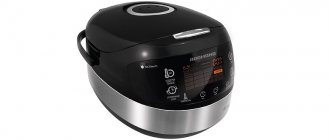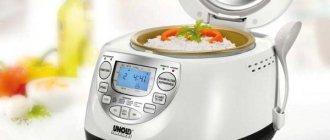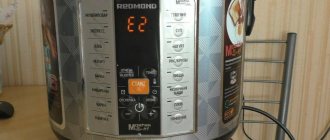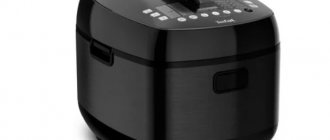A multicooker, in its design and operating principle, is very similar to a simple saucepan on a gas or electric stove. Both have a heating element, a container (pan/bowl), and a lid.
So what's the difference?
The difference between a multicooker lies in its availability:
- temperature sensor,
- microprocessor control,
- lid tightness.
A temperature sensor (temperature sensor, thermostat), together with a simple microprocessor control of the heating element, allows you to automatically maintain the set temperature with fairly high accuracy.
An airtight lid allows for more or less uniform distribution of heat in the bowl and also prevents the flow of oxygen, which affects the quality of cooking.
As was written in the article about the types of multicookers, multicookers are divided according to the type of heating into heating elements and induction.
Multicookers with heating elements
In multicookers of this type, the heating element is a heating element, which is located at the bottom of the multicooker, see Fig. 1 (click to enlarge):
Rice. 1. Disc heating element with a temperature sensor in the middle at the bottom of the multicooker
In the middle of the heating element there is a spring-loaded temperature sensor. The heating element and temperature sensor are made of aluminum and must fit tightly to the bottom of the bowl. The distribution of heat flows is shown in Fig. 2:
Rice. 2. Scheme of operation of a multicooker with heating element heating
A voltage of 220V is periodically supplied to the heating element, which causes it to heat up. The heat from the heating element is transferred to the bowl of food tightly adjacent to it, causing them to gradually heat up. The heat from the bowl with food, in turn, is transferred to a temperature sensor that fits tightly to its bottom. The temperature sensor measures the temperature of the bottom of the bowl and transmits it to the heating element control device. Feedback is formed, due to which the set temperature of the bowl is maintained.
To understand how the heating element control device maintains the set temperature in the bowl, let’s look at the graph (Fig. 3):
Rice. 3. Operating principle of the multicooker heating element (heating option 1 - fast)
On the graph, the horizontal axis shows time, and the vertical axis shows the power consumed by the heating element and the temperature of the bowl.
The heating element operates in ON-OFF mode. When the heating element is turned on, it operates at maximum power, and when turned off, it operates at zero power. Those. it either heats to its fullest or doesn’t heat at all. There are no intermediate options.
Let's say we set the temperature to 95 degrees. After starting the program, the control device turns on the heating element and periodically takes readings from the temperature sensor (i.e., measures the temperature of the bowl). The heating element steams at full power until the temperature exceeds the target 95 degrees. As soon as this happens, the control device will turn off the heating element, but the bowl, by inertia, will continue to heat up for some time, which can lead, for example, to milk porridge running away. For example, in the Polaris PMC 0523 multicooker in the MILK PORridge mode at a target temperature of 95 degrees after initial heating, the actual temperature of the bottom of the bowl after turning off the heating element by inertia reaches 105-107 degrees. Then there is a slow cooling. As soon as the temperature drops below the set 95 degrees, the heating element will turn on again and radiate heat until the temperature exceeds 95 degrees. Further, this process of turning the heating element on and off will be repeated periodically, and the temperature of the bowl will fluctuate around the set temperature.
The shaded rectangles show the operation of the heating element; their area corresponds to the amount of thermal energy released. On the graph, the area of the first rectangle is large, and the rest are small. This means a large amount of thermal energy released by the heating element at the primary heating stage (long pulse, intense heating), and small portions of energy (short pulses) to maintain the set temperature.
The operation of the heating element in the ON-OFF mode is accompanied by characteristic relay clicks in the multicooker.
In the graph above, the first pulse was long (the heating element worked for a long time without turning off, providing intense heating), but in some modes the multicooker can be programmed to initially slowly heat with short heat pulses. In this case, you can immediately hear periodic clicks of the relay immediately after the program starts. On the graph it looks like this (Fig. 4):
Rice. 4. Operating principle of the multicooker heating element (heating option 2 - smooth)
The graph shows that in this case, heating to a given temperature takes several times longer, but it is smoother and more accurate (without large differences). For example, this is how heating occurs in many Polaris multicookers in the MULTICOOK program. Smooth heating can be important at low operating temperatures (up to 100 degrees), such as when cooking sous vide.
CAN A MULTICOOKER DETERMINE THE AMOUNT OF FOODS IN THE BOWL?
The heating intensity can be adjusted depending on the rate of temperature change. For example, if heating occurs slowly (the temperature increases slowly), then the bowl can be heated more intensely, and vice versa: if the temperature increases quickly, then the heating intensity should be reduced. An interesting and obvious point: when there is a lot of food in the bowl, the temperature will change more slowly than when there is little food in the bowl. What does this mean? This means that, based on the rate of temperature change, theoretically, a multicooker can approximately determine the amount of food in the bowl and take this into account.
From the above, it is obvious that for the correct operation of the archi multicooker, it is important that the bowl fits tightly to the heating element and temperature sensor, ensuring maximum thermal conductivity. Otherwise, a violation of thermal conditions will occur with unpredictable consequences.
In multi-cookers-bread makers there can be two heating elements: one on the bottom and the second on the side (click to enlarge):
Rice. 5. Two heating elements in a multi-cooker-bread maker
General principle of operation of a multicooker
The control center of the multicooker is the microprocessor. It contains action algorithms for preparing various dishes - programs or recipes. The microprocessor analyzes the temperature sensor readings and, depending on the selected operating program, changes the heating level of the heating element. It is the thermal heating of the heating element that creates the necessary temperature in the bowl for cooking.
The main thing is that the user does not determine the required heating level and other operating parameters of the multicooker - he only selects one of the programs (recipes) that are preset in the microprocessor. The microprocessor exclusively regulates the operation of the heating element, because during the preparation of various dishes a significant change in temperature may be required.
The simplest devices are equipped with only one heating element, while more advanced ones are equipped with two, three or more. A large number of heating elements guarantees faster and more uniform heating of the device, since they are located over the entire area of the cooking bowl, and not just from below.
The microprocessor constantly “monitors” the temperature indicator and turns the heating element on and off to achieve the temperature range required by a specific recipe. It is worth noting that the amount and type of food in the cooking container directly affects the speed of cooking the dish. Indeed, in the case of a full load, the electric heater will need more time to warm up the bowl to the required temperature
It turns out that based on the rate of change in temperature values, the microprocessor adapts to the amount of food and any dish will always be prepared to the highest possible quality in accordance with the ideal recipe.
It is extremely important that the multicooker bowl is correctly installed in its seat, and full contact of the container with the sensor and heating element is ensured. If this condition is not met, the correct cooking algorithms are completely disrupted, since the microprocessor receives biased information from the temperature sensor.
Multicookers with induction heating
In multicookers with induction heating, the bowl itself acts as a heating element. The bowl is heated using electromagnetic waves (click to enlarge):
Rice. 6. Induction heating
The bowls in such multicookers are thick-walled, heavy, and of high quality. For the distribution of heat flows, see Fig. 7:
Rice. 7. Scheme of operation of a multicooker with induction heating
All the above graphs (Fig. 3 and Fig. 4) also apply to induction multicookers. The heating element in most of them also operates in ON-OFF mode without intermediate power values. In my personal impression, induction heating is more aggressive than heating element. This may be due to the fact that induction multicookers are generally more powerful, resulting in more powerful heat pulses, which leads to sharper temperature changes.
What is :: Multicooker
Recently, technology that speeds up and simplifies all household processes has become increasingly popular. This technique combines the functions of several different devices simultaneously. One of these kitchen innovations was the multicooker.
The ancestor of all steamers, pressure cookers and koshevakas was the pressure cooker invented in the 17th century by Denis Papin for heat treatment of sugar. Since those times, the image of a kitchen appliance has changed significantly and acquired a modern form.
What is a multicooker
The component “multi” indicates multiplicity, multiplicity. This is a universal kitchen appliance that combines the functions of a pressure cooker, steamer, cooker, and bread maker. Thus, using this device you can steam, simmer, fry, bake.
How does a multicooker work?
The multicooker is an “electronic pan” with a removable bowl inside and a tightly attached lid. The lid is tightly connected to the body using a valve that prevents air from entering. The removable bowl is designed for storing food.
The device operates using a microprocessor, which is controlled via a touch screen. Information about time and temperature is reflected on the electronic display.
Manufacturers of multicookers are Thailand and South Korea. The kitchen appliance has gained great popularity in Japan, the USA, Spain and Russia.
What is processor control
Processor control involves alternating high and low pressure, which is called “gentle mode”. In addition, the valve prevents air from entering the device. Thus, the processor controls and creates optimal temperature and pressure. The possibility of excessive temperature occurrence is excluded. Thanks to this property, food does not lose its beneficial and tasteful qualities. For example, an ordinary saucepan with a lid allows air to pass freely, which means the oxidation process occurs. Food inevitably loses its beneficial properties and becomes less nutritious. In addition, the tightness of the device does not allow the liquid to boil, which means the food is not exposed to the mechanical action of boiling water. Products retain their shape. In practice, this can be seen when potatoes and meat are ready at the same time.
Cooking speed
When choosing a multicooker, you need to pay attention to power. The higher the power, the faster the cooking process occurs. Power can be different: 490 W, 670 W, 1400 W. But this is not a decisive point when choosing a device. All multicookers create the optimal “gentle” mode in the same way. This mode is created by maintaining the level of temperature and pressure. All this is possible thanks to energy-saving technology, a uniquely shaped bowl and an inductive heater. Induction heating is a non-contact method of transferring electricity to a heating object. The bowl in which the food is placed is heated evenly, but not due to high temperature. The maximum temperature at the start is 120 degrees, during cooking 80-100 degrees. The induction heater heats the bowl evenly over the entire surface. Due to this, 30% of the time spent with the traditional method of heating dishes on the stove is saved.
Autonomy
When choosing a kitchen appliance, please note that the multicooker has 6 standard cooking programs. The processor is designed in such a way that a person needs to select the required program and close the lid tightly. Then the device will work autonomously for a certain time. The tightness of the valve allows you to leave the device turned on unattended. At the end of the operation, a signal sounds and the multicooker automatically switches to food heating mode (up to 12 hours).
Safety
One of the most important qualities of equipment is safety in use. You need to pay special attention to the way the electrical cord is attached. It is better that it is non-detachable so that water does not penetrate. This will help avoid short circuits. A multicooker can be with or without handles. A multicooker with handles is more convenient to use, as it is easier to carry from place to place. The handles do not heat up. In addition, unlike microwave ovens, the multicooker does not expose a person to electromagnetic radiation. The tightness of the valve prevents getting burned by hot air.
Specifications
Depending on the number of members in the family, you can choose a different multicooker volume . The bowl volume can be from 3.5 to 4.5 liters. A large-capacity multicooker allows you to cook food for 10 people. This is the best option for a large family or organizing holidays. All models of multicookers are equipped with a “soft steam release” system. What does it mean. When the cooking program ends, the multicooker reduces the pressure and gradually releases the accumulated steam. The internal coating of the device may vary : non-stick or 5-layer with marble coating. Both coatings have high wear resistance. Marble coating minimizes the effort required to maintain the device. All models are equipped with a delay start timer . This means that the cooking time can begin at a time convenient for the user. The maximum delay is 13 hours. In practice, it looks like this: in the morning you put food in the multicooker, program it so that the food is ready by 18.00. The device turns on automatically and starts the program. For those who find it difficult to understand electrical appliances, there is a multicooker option with a “voice guide.” This option simplifies management and avoids errors.
The function of automatically switching to heating mode is characteristic of all multicooker models. The pre-soak function is also standard. It is created specifically for preparing cereals and legumes. Temperature programming is possible from 50 to 120 degrees. Food cooked in a slow cooker retains nutrients and vitamins . This is ensured by steam cooking technology (as in a double boiler). The dish is prepared without adding oil or water - in its own juice. Therefore, the possibility of the appearance of carcinogens is excluded. This food is suitable for diet and children's menus.
In conventional steamers, steam passes through holes in the baskets and takes away some of the moisture and flavor of the food. In a multicooker, this is technically impossible, since the lid is hermetically sealed to the body throughout the entire cooking process. All the juices remain inside.
Standard modes
The microprocessor of the multicooker includes several cooking programs: buckwheat, pilaf, milk porridge, baking, stewing, steaming.
The “Buckwheat” mode allows you to cook porridges and side dishes from all types of cereals, peas and beans. The main principle is evaporation of liquid, absorption. By adjusting the volume of liquid, you can choose the consistency of the dish.
The “Pilaf” mode is mainly intended for cooking rice with meat, seafood, and vegetables. At the first stage, the program “evaporates” the liquid from the food, at the second stage it dries and fries the dish. You can cook any other foods in the same way, such as potatoes or pasta.
The “Milk porridge” mode was created specifically for preparing porridge. The convenience is that you can fill the multicooker with cereal and liquid in the evening, program the time, and classic porridge will be ready for breakfast.
The Baking mode allows you to bake and toast foods. Using this mode you can bake pizza, charlotte, muffins, pie (open or closed). In this mode, you can fry the chicken either whole or in pieces, you can do any kind of frying, or brown a dish already prepared in another mode. Baking occurs at a temperature of 180 degrees.
The “Extinguishing” mode is the most convenient. With it you can prepare the most complex dishes consisting of meat, vegetables, and cereals. The important thing is that all these products will be ready at the same time. In this mode, jellied meat, baked milk, soup, and assorted vegetables are equally tasty. The products are not evaporated, but simmered, retaining their taste. Quenching occurs at a temperature of 100-105 degrees.
The “Steam” mode is indispensable for preparing children's and dietary dishes. The food is easily digestible and healthy.
A multicooker will be convenient:
who don’t have enough time, young mothers who often have to cook porridge, who like to cook, who don’t like to cook, who regularly prepare a diet menu.
The cost of a multicooker varies from 3.5 to 23 thousand rubles.
3D - heating
Almost all manufacturers claim in advertising that they have 3D heating (i.e. volumetric, uniform), but in practice this is in most cases an advertising fiction. By 3D heating, pore manufacturers can mean anything (for example, a metal reflective cover), but not full-fledged active heating elements. Even if there is a real heating element in the lid or on the side, most likely it will be a very low-power (only 50-100 W) element that will not be able to have any significant effect (except when preparing yogurt and heating). The number of powerful active heating elements can be determined by looking at the specification or label: for example, if a power of 860 W is indicated, then there is probably only one full-fledged heating element (even if there are two 800+60 W heating elements, this will not make a difference), but if it is indicated , for example: 800W + 700W, then in this case you can count on two full-fledged heating elements (but even in this case you still need to see if it will be possible to use them simultaneously - in this case the manufacturer must also indicate the full power, i.e. 1500W in our example).
Multicooker lid
The cover can be removable or non-removable. A non-removable lid may have a removable nozzle.
Rice. 8. Cap, valve, removable nozzle with O-ring
The lid has a steam release valve and an o-ring, which can be located either on the lid itself or on a removable nozzle (the second option is more convenient for washing). The O-ring is a consumable item and will require replacement after a couple of years.
In multicookers-pressure cookers (with pressure), the lid and the places where the lid is attached to the body are made much more reliable.
Steam release valves for pressure cookers can be divided into the following types:
- Automatic electronic (microprocess controlled)
- Automatic mechanical
- Manual mechanical (opens and closes manually)
Rice. 9. Manual mechanical valve
Control Panel
The control panel consists of buttons and a display. The buttons in most multicookers are touch-sensitive (capacitive, activated by a light touch) and sensor-mechanical (mechanical buttons are hidden behind a sealed film). In the first option, false alarms are likely and there is no tactile sensation, and in the second, the operation is likely to deteriorate over time.
Displays can be liquid crystal (LCD), LED, or fluorescent. Cheap multicookers may not have a display at all. LCD displays can be backlit or not.
Multicooker programs
Ideally, it would be enough to be able to set the temperature and time. All other automatic programs mostly repeat each other and are advertising fiction, especially when the temperature conditions are undocumented. Programs may differ in the aggressiveness of the primary heating (which was discussed above), but again this is not documented anywhere.
There is another important aspect: when does the time countdown begin - immediately after the start or after reaching the set temperature? Recently, manufacturers, unfortunately, are increasingly using the first option (except for FRYING and STEAMING - and there are exceptions), although the second option is personally much more convenient for me, because... The initial heating time depends on many factors and is difficult to predict (it depends on the amount of food, the initial temperature of the food and the environment, and even the voltage level at the outlet). We will return to this issue in more detail in the article on choosing a multicooker.
Also, sometimes you can still find so-called touch programs in which the time is not set - the program stops automatically when the dish (usually cereal) absorbs water. Usually these modes were PILAV and BUCKWHEAT. When there is water in the bowl, its temperature cannot exceed the boiling point (100 degrees). When this threshold is exceeded, it means that all the water has already been absorbed/evaporated and the program automatically stops. The difference between the BUCKWHEAT and PILOV sensor programs is that in the PLOV mode, after the sensor is triggered, short heating occurs for light frying. But sensory programs have become less and less common lately.
An example of the operation of a multicooker during the preparation of a typical dish
The functions and capabilities of an individual multicooker may differ significantly, but in general the cooking algorithm and operating principle are always the same, and we will describe in detail what happens in the multicooker during the preparation of the simplest dish - buckwheat porridge.
What does the temperature sensor record at the moment you start this recipe? It “tells” the microprocessor that the bowl is at room temperature and therefore the heating elements need to be turned on to achieve the operating temperature of this program.
Each multicooker recipe always involves several steps. In our case, reaching the boiling point of water is the end of the first stage of the program.
After this, the microprocessor turns off the heating element and a stable state will be maintained in the bowl, ideal for cooking buckwheat. Periodically, the heating element will turn on for a few seconds to maintain the required temperature. Since buckwheat absorbs a lot of liquid during cooking, after 10-15 minutes there will be almost no water left in the container.
This moment will definitely be “noticed” by the microprocessor due to the change in temperature in the bowl. The second stage of cooking ends and the multicooker proceeds to the final stage. As housewives say, “the porridge is getting through.”
It is worth noting that each stage in the recipe has an exact duration in time and the temperature sensor is not the only one responsible for the cooking time. In our case, the duration of the final stage of preparing the dish according to the “Buckwheat Porridge” program in no way depends on it.
The final stage lasts exactly the amount of time required on average to prepare the ideal porridge, provided that a certain amount of cereal is loaded. Accordingly, if you cook porridge in a multicooker-pressure cooker, the cooking time is reduced.











